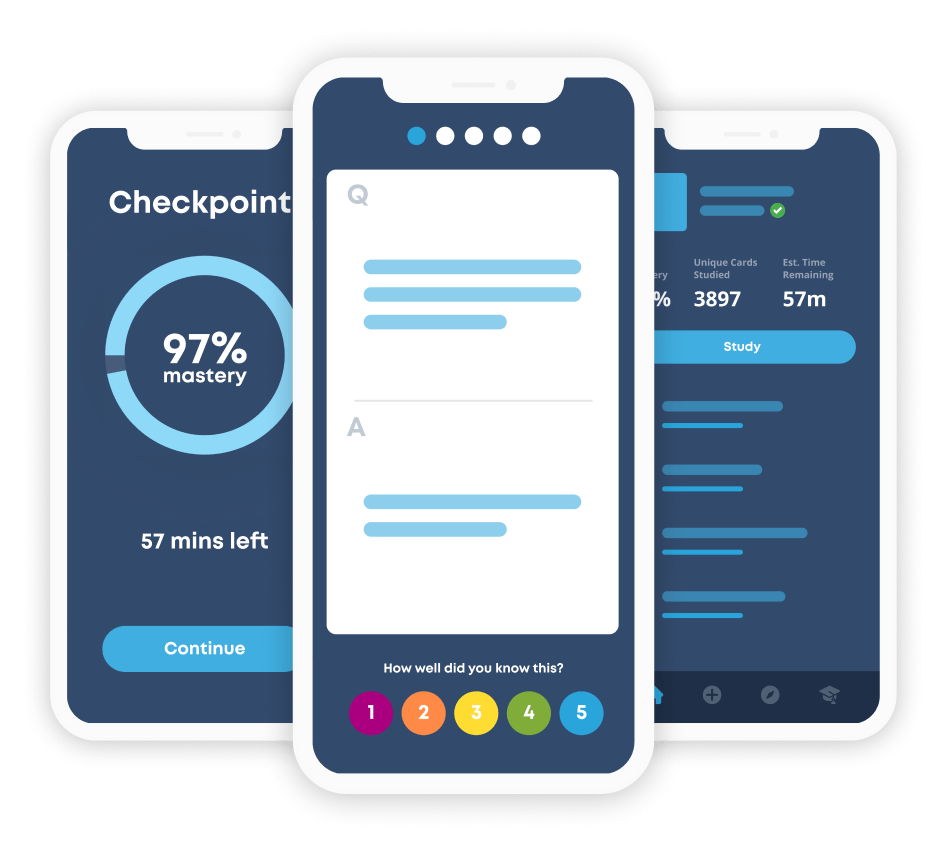Test Prep
Boost your score while shaving days off your study time. Brainscape uses proven cognitive science.

- decks
- flashcards
- learners
Browse these flashcards.
Studying for the FINRA exams? Look no further. In partnership with world-class training experts Knopman Marks, we've provided thousands of adaptive flashcards targeted toward precisely the exams you're looking for. Be sure to check out Knopman Marks' website to see their full range of courses and study materials.
Brainscape is both the most popular and the most effective web & mobile AP exam prep. Over 100,000 students have used our app to score a 5 (while spending LESS time studying). Don't fall behind!
1600+ GRE vocabulary flashcards to accelerate your GRE prep and readiness!
Comprehensive PMP exam flashcards to crush the PMP exam on your first attempt!
All the highest-yield terminology and definitions for the CISSP exam.
All the highest-yield concepts in the GRE Psych textbook, Kaplan, Princeton Review, Barron's & more.
All the highest-yield concepts in the official WSET® Level 1 textbook to pass with distinction.
All the highest-yield concepts in the official Introductory Sommelier (CMS level 1) curriculum.
Covering the AAMC USMLE test plan, First Aid, Rapid Review Pathology, & High-Yield Gross Anatomy.
All the top drugs tested in the official NAPLEX® curriculum.
All the top concepts aligned to all 50 states’ Certified Nursing Assistant (CNA) exams.
All the highest-yield UBE concepts in BarBri, Themis, Kaplan, Adaptibar & other bar exam prep resources.
All the top concepts in the official Cisco Certified Network Associate (CCNA) curriculum.
All the highest-yield concepts in the official NASM Certified Personal Trainer (CPT) curriculum.
Flashcards created by top experts to supplement the official Drivers Test preparation.
Tous les concepts essentiels du livre officiel du Diplôme de niveau 3 en vins du WSET®.
All the highest-yield concepts in Saunders, Kaplan, Lippincott, Hurst, Khan Academy, and HESI NCLEX.
Flashcards created by top experts to supplement the official Drivers Test preparation.
All the top concepts tested by the official UPC Journeyman Plumbing exam.
All the top concepts in the official IPC Journeyman Plumbing exam curriculum.
All the top concepts in the official 2020 Master Electrician exam curriculum.
All the top concepts in the official 2023 Master Electrician exam curriculum.
All the top concepts in the official 2020 Journeyman Electrician exam curriculum.
All the top concepts in the official 2023 Journeyman Electrician exam curriculum.
All the top concepts in the official ServSafe Manager curriculum.
All the top concepts in the official ServSafe Food Handler curriculum.
All the top concepts in the CrossFit Level 1 curriculum. Study efficiently and crush the exam!
Porque o Medcards Ciclo Basico é a sua melhor escolha de revisão?
250+ Adaptive flashcards covering all the highest-yield concepts in the AFC® exam
All the top concepts in the official CFA® Level 1 exam curriculum
All the highest-yield concepts in BarBri, Themis, Kaplan, Adaptibar, BarMax, Critical Pass, & more.
All the highest-yield concepts in the official WSET® Level 2 textbook to pass with distinction.
All the highest-yield concepts in the official WSET® Level 1 Beer textbook. Pass with distinction!
All the highest-yield concepts in the official WSET® Level 2 Beer textbook. Pass with distinction!
All the top concepts in the official CPA exam curriculum.
All the highest-yield concepts in the official WSET® Diploma D1 textbook on Wine Production.
All the highest-yield concepts in the official WSET® Diploma D2 textbook on the Business of Wine.
All the highest-yield concepts in the official WSET® Diploma D3 textbook on Wines of the World.
All the highest-yield concepts in the official WSET® Diploma D4 textbook on Sparkling Wine.
All the highest-yield concepts in the official WSET® Diploma D5 textbook on Fortified Wine.
All the top concepts in the official CMS Certified Sommelier syllabus
All the top concepts in the official WSET® Level 1 Spirits textbook to pass with distinction!
All the top concepts in the official WSET® Level 2 Spirits textbook to pass with distinction!
All the top concepts in the official WSET® Level 3 Spirits textbook to pass with distinction!
CFP exam prep that covers all the top concepts in the CFP® curriculum, Danko, BIFF, Kaplan, & more.
All the highest-yield concepts you need to know to ace your Dermatology Board exam prep.
Flashcards created by top health coaches to supplement official tools or other services.
Flashcards created by top experts to supplement the official Drivers Test preparation.
The world’s best study app to help you master the JLPT.
Flashcards created by top experts to supplement the official Drivers Test preparation.
Use the world's smartest SAT flashcards to supplement official publications and other services.
Everything aspiring realtors need to know to pass the Texas Real Estate License Exam.
Covering the official IBHRE test plan & Cardiac EP, Rhythm Device & Remote Monitoring reading lists.
Flashcards created by top welding experts to supplement the official preparation.
O aplicativo flashcard mais inteligente do mundo para complementar a preparação para o exame da OAB.
1,750+ Adaptive, digital emergency medicine flashcards for fast, efficient RCEM exam preparation.
O aplicativo flashcard mais inteligente do mundo para complementar a preparação para os vestibulares / ENEM.
O aplicativo flashcard mais inteligente do mundo para oftalmologia.
Memoriza con la repetición espaciada los datos clave del IVASPE y optimiza tu estudio.
Porque o Medcards Anestesiologia é a sua melhor escolha de revisão?
Os melhores flashcards de Endocrinologia aliados ao algoritmo de repetição espaçada mais eficaz do mundo para você ser aprovado na prova de título.
Os melhores flashcards de Otorrinolaringologia aliados ao algoritmo de repetição espaçada mais eficaz do mundo para você conciliar os estudos com a residência e ser aprovado na prova de título.
760+ Charter Pilot (Part 135) flashcards to quickly learn the top concepts in the exam.
All the top concepts in the official Praxis exams.
O aplicativo flashcard mais inteligente do mundo para memoriza concurso.
Flashcards de cirurgia geral com o melhor algoritmo de repetição espaçada para te ajudar a estudar com a residência e passar na prova de R+.
Os melhores flashcards aliados ao algoritmo de repeticao espacada mais eficaz do mundo para voce ser aprovado na prova de residencia medica e REVALIDA.
O aplicativo flashcard mais inteligente do mundo para memoriza concurso

The smartest study system.
Brainscape's adaptive, web & mobile flashcards system will drill you on your weaknesses, using a pattern guaranteed to help you learn more in less time.
Easy to add your own flashcards.
Easily collaborate with friends and sync your flashcards to the Brainscape mobile app.


